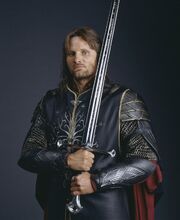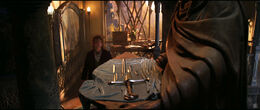Narsil was the powerful sword wielded by Elendil, during the war between the Last Alliance of Elves and Men and Sauron of Mordor, at the end of the Second Age. In the next age, it was reforged into the sword Anduril.
Second Age
War of the Last Alliance
During the final battle between the Last Alliance and Mordor, Narsil broke into two pieces when Elendil and Gil-galad fought Sauron themselves, and although they fought valiantly, they died in the process. Taking up the handle-shard of Narsil after his father's defeat, Isildur cut the One Ring from Sauron's hand, defeating him.
Isildur took the shards home with him. Shortly before Isildur was killed in the second year of the Third Age in the Disaster of the Gladden Fields, the shards were rescued by Ohtar, squire of Isildur. He took them to Arnor, where they passed to the next king, Isildur's son, Valandil.[2]
Third Age

Aragorn holding Andúril, the blade Narsil reforged.
The shards of Narsil were passed down as an heirloom by the heirs to the throne of Arnor among the Dúnedain of the North. The sword's last owner was Aragorn, son of Arathorn.[3]
War of the Ring
Before the Fellowship of the Ring departed Rivendell on the Quest of the Ring, the shards of Narsil were reforged by the Elves into Andúril, which Aragorn carried into the battle of Gondor and the battle of the Black Gate of Mordor, which was fought so Frodo and Sam could throw the ring into the Cracks of Doom in Mount Doom.
Etymology
In Quenya, Narsil means "Red and white flame", from nár ("fire) and thil ("white flame").[4] It symbolizes the Sun and Moon, the "chief heavenly lights, as enemies of darkness".[5]
Other versions of the legendarium
In other writings, Narsil was named Branding, after it was reforged into Andúril.[6]
Portrayal in adaptations
Ralph Bakshi's The Lord of the Rings
In the The Lord of the Rings (1978 film) by Ralph Bakshi, Aragorn uses the sword, which still has the longer part of the blade attached to the hilt, as his primary weapon, before it is reforged.
The Lord of the Rings film trilogy

The shards of Narsil on display in Rivendell.
In the The Lord of the Rings film trilogy directed by Peter Jackson, Narsil was not broken in two but into several parts (which were kept at Rivendell), and is not reforged into Andúril until the third film. Aragorn uses an ordinary sword during the first two films. Prior to the third film, his attitude towards the sword is a mix of reverence and reluctance. On the one hand, he carefully replaces the hilt on its pedestal after Boromir carelessly lets it drop to the floor, but he is reluctant to claim possession of it, as it represents the kingship of Gondor. It is not until the third film that Arwen persuades Elrond to have the sword re-forged by the elves, and Elrond in turn persuades Aragorn to accept it, as the symbol of kingship with which he can command obedience from the Army of the Dead.

Bilbo coming upon the shards while in Rivendell.
In a scene from the extended version (which also appears in the book), Aragorn challenges Sauron by contacting him via the Palantír of Orthanc and showing him "the sword of Elendil" re-forged.
The Hobbit film trilogy
Narsil briefly appears in The Hobbit: An Unexpected Journey Extended Edition.
Translations around the World
| Foreign Language | Translated name |
|---|---|
| Amharic | ኛርሲል |
| Arabic | نارسيل |
| Armenian | Նարսիլ |
| Belarusian Cyrillic | Нарсіл |
| Bengali | ণার্সিল |
| Bulgarian Cyrillic | Нарсил |
| Bosnian | Narsil |
| Catalan | Nàrsil |
| Chinese (Hong Kong) | 納希爾聖劍 |
| Dari | نارسیل |
| Georgian | ნარსილ |
| Greek | Ναρσιλ |
| Gujarati | ણર્સિલ |
| Czech | Narsil |
| Hebrew | נארסיל |
| Hindi | णर्सिल |
| Kazakh Cyrillic | Нарсіл |
| Korean | 나르실 |
| Kurdish | نارسیل (Arabic script) Narsil (Latin) |
| Kyrgyz Cyrillic | Нарсил |
| Macedonian Cyrillic | Нарсил |
| Marathi | णर्सिल |
| Mongolian Cyrillic | Нарсил |
| Nepalese | णर्सिल |
| Persian | نارسیل |
| Punjabi | ਨਅਰਸਿਲ |
| Russian | Нарсил |
| Serbian | Нарсил (Cyrillic) Narsil (Latin) |
| Sinhalese | ණර්සිල් |
| Tajik Cyrillic | Нарсил |
| Tamil | ணர்ஸில் |
| Telugu | ణర్సిల |
| Turkish | Narsil |
| Ukrainian Cyrillic | Нарсіл |
| Urdu | نآرسال |
| Uyghur | نارسىل |
| Uzbek | Нарсил (Cyrillic) Narsil (Latin) |
| Yiddish | נאַרסיל |
| Barrow-blades • Sting | |
| Durin's Axe • Orcrist | |
| Grond (battering ram) • Grond (hammer) • Morgul-knife | |
| Aeglos • Anglachel • Anguirel • Angrist • Aranrúth • Belthronding • Dailir • Glamdring • Orcrist • Ringil | |
| Andúril • Dramborleg • Black arrow • Dagmor • Gúthwinë • Gurthang • Herugrim • Narsil • Red Arrow | |
References
- ↑ The Lord of the Rings, The Two Towers, Book Three, Chapter VI: "The King of the Golden Hall"
- ↑ 2.0 2.1 The Silmarillion, Of the Rings of Power and the Third Age
- ↑ The Lord of the Rings, The Fellowship of the Ring, Book Two, Chapter II: "The Council of Elrond"
- ↑ The History of Middle-earth, Vol. 5: The Lost Road and Other Writings, Part Three: "The Etymologies"
- ↑ The Letters of J. R. R. Tolkien, 347 To Richard Jeffery
- ↑ The History of Middle-earth, Vol. 8: The War of the Ring, Part Three: Minas Tirith, IX: "The Battle of the Pelennor Fields", Notes
